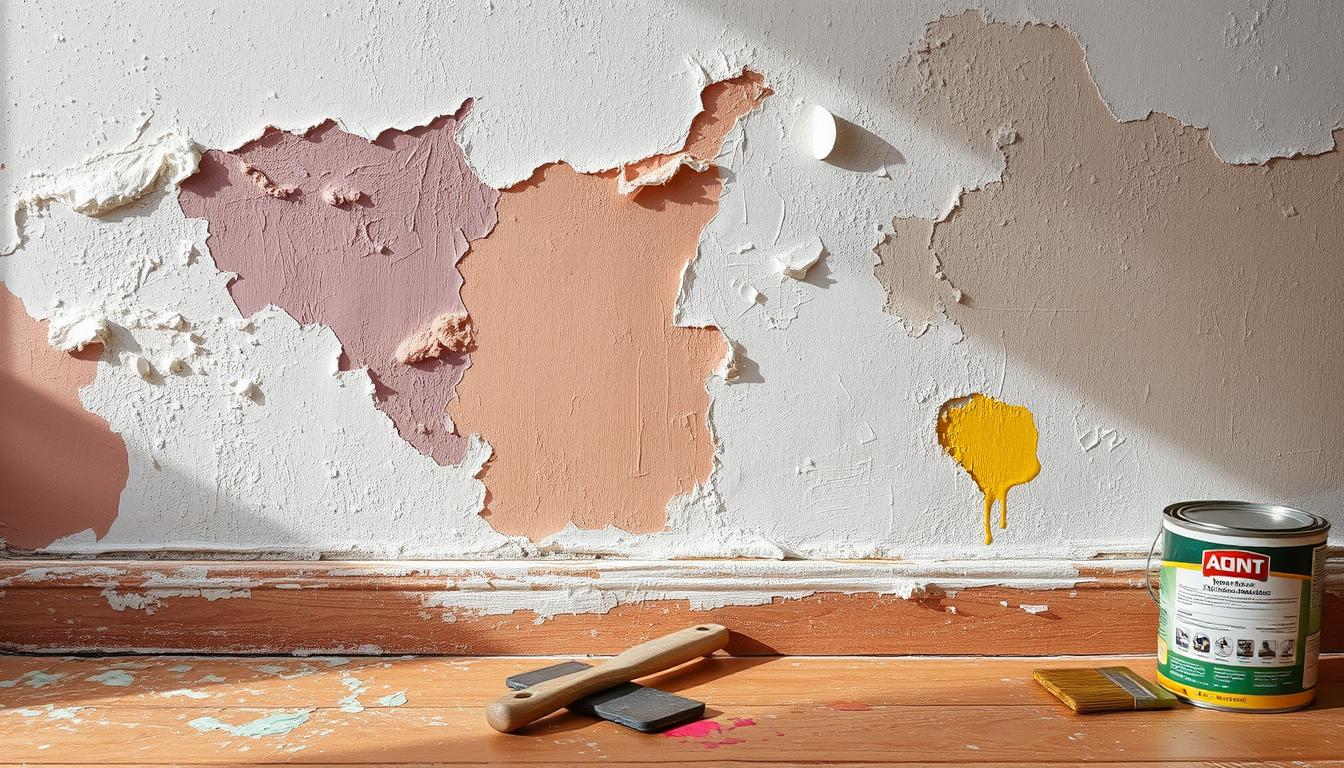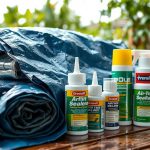Paint problems can be frustrating and affect the overall appearance of a room. Issues like paint defects, discoloration, and cracking are common and hard to fix. It’s crucial to understand the causes of these problems for effective troubleshooting. By identifying the root cause, homeowners and DIY enthusiasts can resolve the issue and achieve a beautiful finish.
This guide will cover the most prevalent paint problems and provide step-by-step solutions. Whether it’s addressing discoloration, cracking, or other paint issues, we will give you the necessary information.
Introduction to Paint Troubleshooting
Paint problems can stem from various factors, including environmental conditions, surface preparation, and paint quality. Understanding these factors helps individuals prevent paint defects and common issues. This guide will offer a comprehensive overview of common paint problems and practical solutions for fixing them.
Key Takeaways
- Identify the root cause of paint problems to effective troubleshooting
- Understand the impact of environmental factors on paint quality
- Proper surface preparation is essential for preventing paint defects
- High-quality paint can help prevent common issues
- Step-by-step solutions can help fix paint problems
- Regular maintenance can help prevent future paint issues
- Addressing paint problems promptly can help prevent further damage
Understanding Common Paint Problems and Their Causes
Several factors influence paint issues. Environmental elements like sunlight, moisture, and temperature changes can impact paint quality. A well-prepared surface is crucial for a durable paint finish. High-quality paint also plays a significant role in preventing common problems.
Common paint problems include discoloration, staining, cracking, and peeling. These issues stem from various causes, including poor surface preparation, low-quality paint, and environmental factors. Understanding the importance of surface preparation and paint quality is key to preventing these problems.
Environmental Factors Affecting Paint Quality
Sunlight and moisture can cause paint to fade, crack, or peel. Temperature changes can also affect paint quality, leading to expansion and contraction. This can result in paint issues like cracking and peeling.
Impact of Surface Preparation on Paint Issues
A well-prepared surface is vital for a durable paint finish. Poor surface preparation can lead to paint peeling and flaking. It’s crucial to clean and prepare the surface before painting to ensure a strong bond between the paint and the surface.
Role of Paint Quality in Problem Prevention
High-quality paint can prevent many common paint issues. Such paint is formulated to withstand environmental factors like sunlight and moisture. It provides a durable and long-lasting finish. Choosing a high-quality paint suitable for the surface and environment is essential.
Identifying Surface Discoloration and Staining
Surface discoloration and staining are common paint defects. They can stem from water damage, mold, and mildew. It’s vital to pinpoint the cause of the discoloration. Water spots indicate water damage, while mold and mildew lead to staining. Knowing the differences is key to finding the right solution.
Exploring the causes of surface discoloration and staining reveals a variety of factors. Some common culprits include:
- Water damage, which can lead to water spots and staining
- Mold and mildew, which can cause staining and discoloration
- Poor surface preparation, which can lead to paint defects
Addressing surface discoloration and staining requires a methodical approach. First, identify the cause. Then, decide on the best action. This might involve cleaning, applying a primer, or using a specialized paint. Understanding the cause and taking the right steps can prevent further defects and ensure a lasting finish.
Being mindful of common surface discoloration and staining can help maintain a flawless paint finish. Regular maintenance and inspections are crucial. They help spot issues early, reducing the risk of defects and preserving a stunning finish.
Dealing with Paint Cracking and Peeling
Paint cracking and peeling can mar the look and lifespan of a painted surface. These issues stem from various factors, including subpar surface prep, low-grade paint, and environmental factors. Understanding the causes and the role of surface prep is key to resolving these problems.
Ensuring proper surface preparation is vital in preventing paint issues. This involves cleaning the surface, filling any imperfections, and applying a primer. This creates a solid foundation for the paint, leading to a durable and attractive finish.
Different Types of Paint Cracks
There are several types of paint cracks, each with its own characteristics. Hairline cracks are tiny, fine lines that can appear on the paint’s surface. Craze cracks are larger, often caused by paint shrinkage or expansion. Checking cracks are small, patterned cracks that result from rapid paint drying.
Step-by-Step Repair Process
To tackle paint cracking and peeling, follow these steps:
- Clean the surface to remove any dirt or debris
- Fill any holes or cracks with a filler
- Apply a primer to the surface
- Paint the surface with a high-quality paint
By adhering to these steps and employing effective surface prep, you can prevent paint issues. This ensures a beautiful, enduring finish.
Addressing Bubbling and Blistering Issues
Bubbling and blistering paint problems can be tough to solve. They often stem from trapped moisture or painting in direct sunlight. Understanding their causes and applying the correct paint solutions is key.
Poor surface preparation, high humidity, and subpar paint are common culprits. To avoid these issues, ensure proper surface prep and use high-quality paint. This helps it withstand various environmental conditions.
- Scrape off the affected area and reapply paint
- Use a paint with built-in moisture-resistant properties
- Apply a primer to the surface before painting
By adhering to these guidelines and selecting the right paint solutions, you can tackle bubbling and blistering effectively. This will result in a smooth, durable paint finish.
Solving Paint Adhesion Problems
Ensuring paint adhesion is key to a paint job’s durability and longevity. Adhesion issues can cause peeling and flaking, compromising the paint’s quality. Understanding the causes of adhesion failure is crucial. These include inadequate surface preparation and using the wrong paint for the surface.
Surface testing is vital for identifying potential adhesion problems. It helps determine if the surface is ready for painting and spots areas needing extra prep. This includes checking for dirt, oil, or contaminants that can hinder paint adhesion.
Common Causes of Adhesion Failure
- Inadequate surface preparation
- Using the wrong type of paint for the surface
- Contaminants on the surface, such as dirt or oil
To achieve good paint adhesion, the right techniques and materials are essential. Using a primer can create a strong bond between paint and surface. Applying paint carefully also helps prevent adhesion issues. Regular surface testing and following these steps can prevent adhesion problems and ensure a lasting, high-quality finish.
Recommended Fixing Techniques
Understanding adhesion failure causes and using the right methods can fix these problems. This includes re-preparing the surface, re-applying primer, and re-painting. With the correct approach, you can overcome adhesion issues and achieve a beautiful, lasting paint finish.
Tackling Moisture-Related Paint Damage
Moisture damage is a major cause of paint issues like peeling, blistering, and discoloration. Understanding how moisture impacts paint is crucial. It’s also important to have effective solutions to prevent and repair these problems.
Common signs of moisture damage include water spots, peeling paint, and discoloration. To tackle these issues, consider the following steps:
- Identify the source of moisture and address it
- Use a moisture-resistant paint or coating
- Ensure proper ventilation in the area
By following these steps, you can prevent moisture damage and achieve a lasting, beautiful paint finish.
Problem-solving is essential when dealing with moisture-related paint damage. Understanding the causes and taking proactive steps can prevent costly repairs. This ensures a professional-looking finish. Paint defects can be a significant problem, but with the right approach, you can overcome them and achieve a stunning paint job.
| Moisture-Related Paint Damage | Cause | Solution |
|---|---|---|
| Peeling paint | High humidity | Use a dehumidifier, ensure proper ventilation |
| Discoloration | Water spots | Use a moisture-resistant paint, address the source of moisture |
Professional Solutions for Stubborn Paint Problems
Dealing with stubborn paint problems often requires professional help. Paint specialists offer expert solutions for issues that DIY methods can’t handle. Their services save time and money by ensuring a complete and efficient fix.
Before hiring a professional, consider the costs. The price for a paint specialist varies by location, problem type, and damage extent. Yet, professional help can be more economical than DIY attempts that may fail or worsen over time.
Factors to Consider When Hiring a Paint Specialist
- Experience and reputation: Choose paint specialists with a history of solving similar paint problems.
- Cost: Compare prices and services from different specialists to find the best value.
- Qualifications: Make sure the specialist has the right qualifications and certifications for your paint problem.
By evaluating these factors and opting for professional solutions, you can ensure your paint issues are fixed efficiently. Remember to weigh the costs and choose qualified paint specialists for the best results.
Benefits of Hiring a Professional Paint Specialist
Hiring a professional paint specialist offers many advantages. They bring expert knowledge, specialized equipment, and a guarantee of quality work. Investing in professional solutions means a beautifully finished, long-lasting paint job that boosts your property’s appearance and value.
| Benefits | Description |
|---|---|
| Expert Knowledge | Professional paint specialists have extensive knowledge and experience in resolving paint problems. |
| Specialized Equipment | Paint specialists use specialized equipment to ensure efficient and effective resolution of paint problems. |
| Quality Workmanship | Professional paint specialists guarantee high-quality workmanship, ensuring a beautifully finished paint job. |
Preventing Future Paint Issues
Ensuring a beautiful and lasting finish is key. By adopting best practices for paint application, one can achieve a smooth finish. This involves surface preparation, priming, and using top-notch materials.
Regular upkeep is vital to avoid paint problems. A maintenance routine helps spot damage or wear early. Quality checks for paint defects or inconsistencies are also crucial.
Best Practices for Paint Application
Using high-quality paint and applying thin coats are essential. Each coat must dry fully before adding the next. The right tools, like rollers and brushes, are necessary for a flawless finish.
Maintenance Tips and Schedules
Regular maintenance prevents paint issues. This includes cleaning the paint and checking for damage. A schedule helps keep the paint in top condition.
Quality Control Measures
Inspecting the paint for defects or inconsistencies is vital. Look for signs of cracking, peeling, or fading. Addressing these issues promptly is key.
By adhering to these practices and tips, one can prevent paint problems. This approach saves time and money, ensuring the paint remains beautiful and durable. Regular maintenance and quality control are essential for a long-lasting finish.
| Prevention Method | Description |
|---|---|
| Regular Maintenance | Inspecting the paint for any signs of damage or wear, and touching up any areas that need it. |
| Quality Control Measures | Inspecting the paint for any defects or inconsistencies, and addressing any issues promptly. |
| Best Practices for Paint Application | Using high-quality paint, applying thin coats, and allowing each coat to dry before applying the next. |
Conclusion: Maintaining Beautiful Paint Finishes
Maintaining beautiful paint finishes is a continuous effort that demands dedication and the right maintenance. Understanding the common paint problems and knowing how to troubleshoot and fix them is crucial. This way, homeowners and DIY enthusiasts can enjoy long-lasting and attractive paint results.
Regular inspections and quick action to address issues are essential. Using high-quality materials also plays a significant role in preventing paint problems. Following best practices for paint application, sticking to maintenance schedules, and focusing on quality control are all vital. These steps contribute to the longevity and beauty of your home’s paint finishes.
With the correct approach and a proactive stance towards addressing problems, you can keep your painted surfaces looking stunning. This will help create a welcoming and well-maintained living space. By adopting the strategies discussed in this guide, you’ll be well on your way to achieving and preserving the paint solutions you desire.


